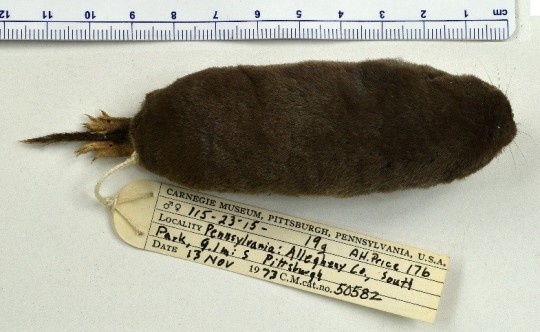By John Wible
When most people in New England, the Mid-Atlantic states, and the Upper Midwest find this small, brown, tubular mammal in leaf litter in their yard they call it a mole. In fact, it is not a mole, but a relative of a mole called a shrew. More specifically, it is a northern short-tailed shrew, Blarina brevicauda. Like moles, the northern short-tailed shrew has degenerate eyes, spends most of its time in underground burrows, and feasts on earthworms and other invertebrates. Estimates are that it eats its weight per day to maintain its high metabolic rate; food consumption has to increase in winter to survive the cold. Life span is short by our standards, with most not living more than a year. To aid in procuring food, the northern short-tailed shrew has a salivary gland that produces venomous saliva that either kills or paralyzes its prey. Biochemically, it resembles some snake venom and starts the digestive process by breaking down protein. Vision is not this shrew’s forte, but I have seen them successfully cross a busy two-lane road in the North Hills of Pittsburgh! How? They echolocate, using high-pitched clicks, and have a heightened sense of smell.

There are more than 350 species of shrews found on all continents except Australia and Antarctica. Not all shrews spend the majority of their time underground. Some tropical shrews in Africa and Asia forage in bushes and small trees and there are even aquatic shrews! They are all small though and with a similar tubular body plan. The largest shrew is about 6 inches long and weighs 100 grams. The smallest, the Etruscan pygmy shrew, Suncus etruscus, is less than an inch and a half in length and weighs only 1.8 grams; it is the smallest living terrestrial mammal by weight.
In Old English, shrews were superstitiously feared and were believed to have a venomous bite, which is not true as shrews in England are not venomous; in fact, our North American Blarina brevicauda is the only venomous shrew species. These small mammals became the source of another usage for the word shrew as an evil or scolding person, used in that sense since at least the 11th century and made immortal by Shakespeare’s The Taming of the Shrew. Despite the intention of the title, Blarina brevicauda cannot be domesticated!
John Wible, PhD, is the curator of the Section of Mammals at Carnegie Museum of Natural History. John’s research is focused on the tree of life of mammals, understanding the evolutionary relationships between living and extinct taxa, and how the mammalian fauna on Earth got to be the way it is today. He uses his expertise on the anatomy of living mammals to reconstruct the lifeways of extinct mammals. John lives with his wife and two sons in a house full of cats and rabbits in Ross Township.
